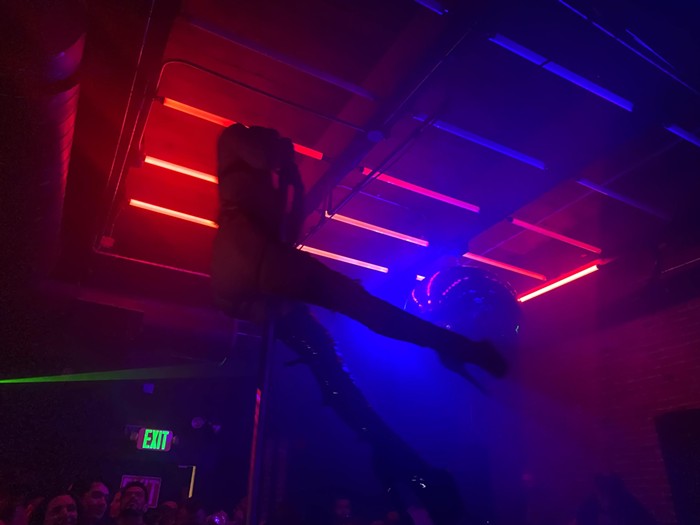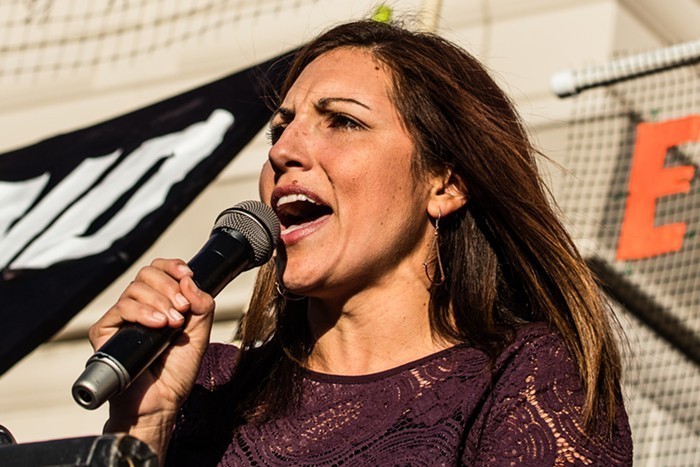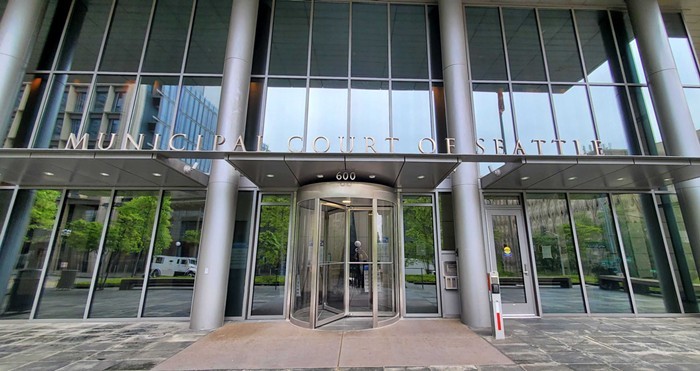Captain Mike Sanford, today's incident commander, tells his officers to be "nice to the nice people," look sharp, and act professional.
Immediately after roll call, Sanford steps into the mobile precinct, a blue-and-white police station on wheels, similar to an RV, to go over his notes and the day's schedule. He's a youthful man--reminiscent of a sandy-blond Southern California surfer--dressed in the standard blue police uniform, with shiny brass rank bars.
"This is going to be a 12- to 14-hour day," Sanford, 41, observes matter-of-factly. Sanford usually works Monday through Friday, and is missing out on a day with his kids. Instead, his father, a retired Seattle police officer, gets to hang out with the grandkids today.
Sanford will be overseeing the SPD as they police the 4/20 protests against the war in Afghanistan, the World Bank, the International Monetary Fund, and Israeli occupation.
At 10:00 a.m., wearing dirty, oversized Levi's, Birkenstocks, and a long-sleeve black shirt, Shannon Kachel, 18, sits on a bench in Westlake Park waiting for the noon anti-war demonstration. A flock of pigeons flies away when the six horse-mounted officers hit the pavement in front of the bench.
Although he feels intimidated by the horse patrol, Kachel is fired up about the day's activities.
"My outlook for the day is to raise as much hell as I can and hopefully not get arrested," Kachel says. He's nearly six feet tall and has the arms of a baseball slugger. His curly hair frames his young face. His voice is deep and hoarse, and will get even scratchier by the end of the day.
Kachel, who recently got his first tattoo, a Hopi symbol for evolution and change on his ankle, is this year's 4.0 valedictorian at Garfield High School and a veteran Seattle protester. (He got stung with a couple of rubber bullets during the 1999 WTO protests, when he was just 15.) He and his father, who is part of the Interfaith Network of Concern for the people of Iraq (INOC), arrived early today, among the few people at Westlake setting up equipment before the crowds arrive.
Kachel helped erect a giant nylon nuclear warhead balloon--by far the largest anti-war ornament there. He tugs on a yellow rope to correct the increasingly limp phallus, which keeps flopping in the breeze.
Just before noon, right on schedule, a cacophony of alarm clocks, bells, gongs, crowing roosters, and whistles erupts from the crowd, sounding like an orchestra that misplaced its conductor. This protest calls for an end to the War on Terrorism, the sanctions against Iraq, and the Israeli occupation.
"These people are great--they're not [protesting] because it's the cool thing to do. They actually believe in it," Kachel says, gazing over the crowd of energetic veteran activists.
Just after 1:00 p.m., Sanford, stationed at the Westlake Starbucks, is approached by a youngish thirtysomething woman with long, dyed-red hair. The woman requests a march permit for the protesters. The majority of the nearly 500 folks at Westlake want to walk up Pine Street toward Seattle Central Community College. Without a permit, marchers have to stay on sidewalks. A permit allows marchers to use the streets, with a police escort.
Minutes after the permit request, though, another rally organizer--an older man who's organized protests like N30--says the group will stick to the sidewalks, and they'll begin walking in five minutes. Sanford opts to follow the sidewalk plan. He says he can't close the street on such short notice.
"We can't do things on the fly," he says. "But if they're marching up the sidewalk, we'll help them get there." As Sanford walks up Pine from Westlake to Eighth Avenue, near the Paramount Theatre, he has time to chat about himself--the protest is still low-key. Sanford, the top cop at the West Precinct, didn't always envision himself as the police maestro at protests.
"I wanted to be an elementary-school teacher," he says. As it turned out, there weren't many jobs in teaching when he graduated, so he followed his father's footsteps and became a police officer. He's now a leader on police response to protests; he traveled to Quebec City in 2001 to observe police tactics at the anti-globalization protest.
At Eighth Avenue, Sanford looks downhill toward the marchers making their way up the street. When the light changes, Sanford crosses Pine, hops into a police van, and zooms up Capitol Hill to SCCC.
Twenty minutes later, Kachel is at SCCC with the rest of the crowd. They've been joined by the Infernal Noise Brigade (INB), a misfit marching band clad in black and orange that came up from First and Union.
The INB, banging on drums, pots, and pans, leads the crowd to the SCCC gym. Most of the protesters--Kachel among them--file into the building for a teach-in about the International Monetary Fund and World Bank, with speakers like lefty King County Council Member Larry Gossett. The gym is packed. Kachel takes a seat in the middle of the bleachers. Soon his hunger pangs win out, though, and he heads two blocks south to Taco Del Mar to feast on a burrito. The police take a power-lunch break too. Parked behind the college, officers sit in a van eating Subway sandwiches and listening to NPR.
As the clock inches toward 4:00 p.m., Sanford meets with his lieutenants in the parking lot of Bonney-Watson Funeral Home, two and a half blocks north of Taco Del Mar on Broadway. They lay out a plan to keep the streets clear. The activists had planned to take over an intersection for a street party at 4:00, but they didn't have the required permit. A street-use permit is required to block an intersection; their action would be illegal.
"None of us have any interest in stifling their message," Sanford says, in by-the-book fashion. "But they've got to play by the rules."
Sanford directs over a dozen officers on bikes to stand just off the sidewalk of SCCC's plaza, along the west side of Broadway, to keep activists off the street. If enough people get past officers and into the street, Sanford says, police will surround the group and make arrests. Minutes later, cops are hauling protective gear out of police car trunks. After they get suited up, the heavily attired cops wait out of sight; meanwhile, the bike cops ride off to station themselves.
Sanford joins the bike officers by SCCC's plaza, watching to see if the crowd moves toward the street. After a few minutes, he gets back into his police van and drives out of sight. So far, at Broadway and Pine, the crowd hasn't leaked into the street.
Kachel meets up with his girlfriend, Tavia--a casually dressed Garfield student with a bright face--and listens to the two bands at SCCC's plaza. Then at 5:00 p.m., in what seems to be a surprise move (to most of the protesters, anyway), the INB leads the mostly college-age crowd north on Broadway. Most participants, Kachel included, don't know the destination. At the corner of Broadway and Thomas, INB halts the march. They spill into the street without a permit, blocking traffic in all directions. Four demonstrators erect a tripod, and a young woman whose arrest scene will grace the 11 o'clock news, climbs to the top, dangles in mid-air, and cheers. Customers of nearby businesses, like Bank of America, Washington Mutual, Angel's Thai Cuisine, and Julia's Restaurant, gawk in curiosity.
Despite Sanford's initial surround-and-arrest plan, there are no police in sight. On either side of the crowd, confused drivers redirect themselves and make swooping U-turns.
At Broadway and Thomas, everyone starts dancing. Three "peace fairies" clad in turquoise, yellow, and fuchsia skirts twirl near Kachel. Clowns with face paint and fake eyelashes throw confetti in the air.
"I expected this [rally] to be more potent. It's kind of a nice symbolism, but I can smell that it's 4/20," Kachel says, referring to the drifting clouds of pot smoke. "Shit like this is why the hippie movement wasn't successful. I'm sure all these people want changes, but mainstream America won't understand this [street party]."
Hushed rumors that the cops are planning a massive ambush creep through the crowd; Kachel just assumes the cops are waiting nearby.
He's right. In the parking lot behind Bank of America, southeast of the blocked intersection, police vans are waiting. Sanford changed tactics once he saw exactly what the protesters were doing, opting to let it play out and arrest a few key participants.
"As early as [the girl on the tripod] came down, the plan was to arrest her and the three that facilitated that [tripod]," he says an hour later.
Two minutes before six o'clock, as the girl rappels down off the tripod, a squad of officers decked out in full black protective gear appear with hefty bikes and pepper spray, and march toward the center of the pack. They quickly take a few people into custody, pinning some suspects to the ground--these are several of the 19 total arrests that day--and try to break free of the crowd.
Kachel steps forward and raises his fingers to make a peace sign, inching closer to the cops. Other protesters around him seem confused. Several kids hurl projectiles toward the cops: a glass bottle breaks at one officer's feet, and a few sticks from protest signs fly over people's heads. Cops hold their bikes up to push back the crowd, and some officers use streams of pepper spray to hold back the most active protesters.
The crowd surges backwards. "Water, please. That shit got in my mouth," a masked kid hollers.
When Kachel emerges from the crowd, he's dripping with white paint. Someone had tossed a paint-filled balloon.
Several protesters run up to him and ask, "Did the cops do that to you?"
"No," Kachel tells them, smiling at the accusations. "It was someone from the crowd. I think it was a protester with a bad arm," he says, wiping off his neck. People start trickling away from the intersection and back to SCCC. Kachel wants to clean up and find his girlfriend. He heads to SCCC.
The police eventually retreat back to the parking lot, get into vans, and drive away.
It's nearly sunset when Kachel gets to SCCC and rejoins the thinning group, which reassembles and marches back to Westlake in a permitted march led by the INB. They reach Westlake just after 7:00 p.m. Kachel dances with members of the INB near the park bench where he had started the day. Overall, Kachel thinks the police did a fair job.
"I thought they weren't antagonistic at all. They were reactionary to people harassing them. They didn't retaliate, which is cool," he says.
A few minutes later, Kachel caught a bus back to the U-District to his girlfriend's house and took a shower. His clothes are pretty much covered with paint, he told us a few days later. The day is slowly winding down, and the air is chilly again. Most of the crowd has gone home--there are only about 200 people left.
Sanford takes up a post near the water fountain in Westlake Plaza. He glances at his watch, which reads 7:15. "The Mariners game started at 7:05.... I'd like to catch some of it," he says with a smile. "They'll probably clear out around 8:00."
An hour and a half later, Sanford is back at the West Precinct, at Eighth and Virginia, waiting to greet the harsh lights of TV news cameras. The reporters pepper him with questions about the protesters' allegations of harsh police action and violent arrests. He keeps his statements brief and upbeat.
"It went very well," he says. "I think the police were very, very restrained."


















